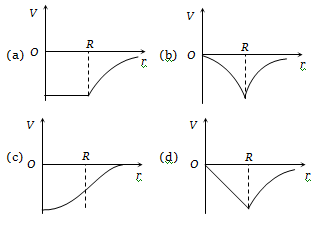The radius of orbit of a planet is two times that of the earth. The time period of the planet is:
1. 4.2 years
2. 2.8 years
3. 5.6 years
4. 8.4 years
The diagram showing the variation of gravitational potential of earth with distance r from the centre of earth is -
| 1. |  |
2. |  |
| 3. |  |
4. |  |
| 1. | \(16L\) | 2. | \(64L\) |
| 3. | \(L \over 4\) | 4. | \(4L\) |
The condition for a uniform spherical mass m of radius r to be a black hole is [G= gravitational constant and g= acceleration due to gravity] .
1.
2.
3.
4.
A sphere of mass M and radius R2 has a concentric cavity of radius R1 as shown in figure. The force F exerted by the sphere on a particle of mass m located at a distance r from the centre of sphere varies as .

| 1. |  |
2. |  |
| 3. |  |
4. |  |
Which one of the following graphs represents correctly the variation of the gravitational field (I) with the distance (r) from the centre of a spherical shell of mass M and radius a ?
| 1. |  |
2. |  |
| 3. |  |
4. |  |
Suppose, the acceleration due to gravity at the earth’s surface is 10 and at the surface of Mars, it is 4.0 . A 60 kg passenger goes from the earth to Mars in a spaceship moving with a constant velocity. Neglect all other objects in the sky. Which part of the figure best represents the weight (net gravitational force) of the passenger as a function of time ?
1. A
2. B
3. C
4. D
Which of the following graphs represents the motion of a planet moving about the sun ?
| 1. |  |
2. |  |
| 3. |  |
4. |  |
The correct graph representing the variation of total energy (), kinetic energy () and potential energy (U) of a satellite with its distance from the centre of the earth is -
| 1. |  |
2. |  |
| 3. |  |
4. |  |
What is the intensity of gravitational field of the centre of a spherical shell?
1.
2. g
3. Zero
4. None of these








